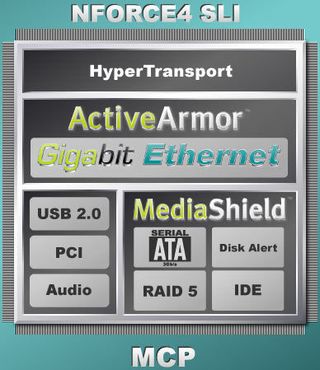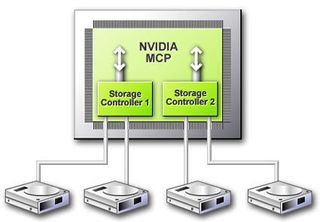NVIDIA nForce4 Intel Edition Sets Its Sights on Intel 925XE
South Bridge / nForce4 MCP
As mentioned earlier, the MCP comes with 10 USB 2.0 ports, five 32 bit PCI slots, a classic 7.1 channel sound system with an SP/DIF option, and NVIDIA's Gigabit Ethernet controller including the firewall with hardware-assisted stateful packet inspection. It also has two storage controllers: a traditional dual channel UltraATA/133 device, and an AHCI-compatible SATA device with support for native command queuing, 3 GBit/s operation and various RAID modes.
MediaShield


NVIDIA decided to split up the SATA controller into two logical units.
Unlike what Intel is offering with its ICH6 chip, the nForce4 MCP comes with two independent SATA controllers. They support native command queuing (NCQ) and 3 Gbit/s operations. Both adhere to the SATA II specification.

Command Queuing allows a hard drive to line up incoming commands so they can be executed in the most efficient order.
NVRAID: RAID 5 For Everybody
The nForce4 IE supports the ordinary RAID modes: RAID 0 (striping), RAID 1 (mirroring) and RAID 0+1 (a combination of striping and mirroring using four drives). But it goes a step beyond that in supporting the more sophisticated RAID 5 too. RAID 5 basically works like RAID 0, distributing chunks of data over all available drives. However, it also creates parity information when writing. That means a stripe set can keep working even if one drive fails - with RAID 0 a single drive failure means loss of the whole array.
That sounds great, but there are two disadvantages when deploying a RAID 5 array. One is that the parity information is distributed across all drives, which reduces the net capacity of the array by one drive. The second is that calculating parity information in real time requires a lot of processing power. Due to that, all professional RAID controllers come with a dedicated RISC processor - the so-called "XOR engine" - to take care of the parity workload.
So why would RAID 5 make sense then? If performance is all you want, it usually doesn't. But let's not forget that Intel will soon be delivering dual-core Pentium D and Pentium Extreme Edition processors. If you were always wondering what you could use all the extra processing power of the second core for, here is one idea.
Stay on the Cutting Edge
Join the experts who read Tom's Hardware for the inside track on enthusiast PC tech news — and have for over 25 years. We'll send breaking news and in-depth reviews of CPUs, GPUs, AI, maker hardware and more straight to your inbox.
Most Popular

